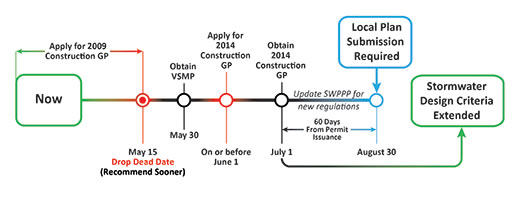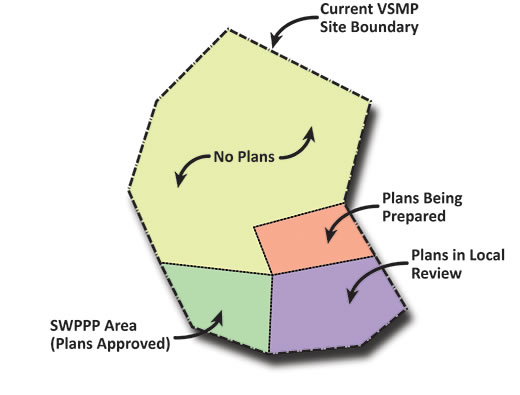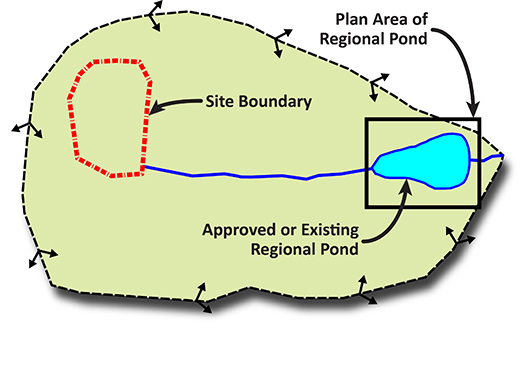The Department of Environmental Quality (DEQ) is working diligently to address the numerous questions and clarifications needed to implement the new Virginia Stormwater Management Program (VSMP) Regulations (9VAC25-870) and the General Virginia Pollutant Discharge Elimination System (VPDES) Permit for Discharges of Stormwater from Construction Activities (9VAC25-880) set to take effect on July 1 of this year (see Field Notes, Vol. 21, No. 10). Small changes are also expected as House Bill 1173 (which could be modified by the Governor) is implemented. |
| There are two recent documents issued by DEQ to help with implementation: |
| A. |
Guidance Memo No. 14-2002, dated 3/7/14 – which provides guidance on Plan Approval Requirements |
| B. |
Frequently Asked Questions, dated 1/23/14 and revised 2/10/14 (with old date) |
| The following discussion highlights issues that are of interest to many land owners, local regulators, site civil engineers and land use attorneys: |
| 1. |
Stormwater Management (SWM) Design Criteria Extension – It is possible to obtain and extend coverage under today’s SWM design criteria (9VAC25-870-47 and 9VAC25-880-50.A.2) for projects that are under construction and for some that are under design review. This can be accomplished for a period of two permit cycles (10 years) by adhering to the following schedule:
|
 |
|
The key issue to remember is that per the DEQ Guidance Memo No. 14-2002, you must have a 2009 Construction General Permit (GP), apply for reissued 2014 Construction GP, and submit the project’s Erosion and Sediment Control (ESC) Plans to the locality no later than 60 days after the date of coverage under the 2014 General Permit in order to maintain a valid 2014 Construction General Permit and still use the current SWM Design Criteria. |
| |
| 2. |
Grandfathering – Another option that will provide coverage under the current SWM design criteria for one permit cycle (5 years) is to obtain locality concurrence that your project is grandfathered (9VAC25-870-48.A). This will require that the following criteria be met: |
| |
a) |
A proffered REZ or other plan listed in the regulations that was approved prior to 7/1/12 (YES – two thousand twelve – that is not a typo!) and meets the following criteria: |
|
|
• |
Provides a layout per 9VAC25-870-10 |
| |
|
• |
Complies with Part II C technical criteria |
| |
|
• |
No modification that results in an increase in total phosphorous (TP), volume, or rate has occurred |
| |
b) |
A Construction GP is not issued prior to 7/1/14 |
| |
c) |
Land disturbance does not commence before 7/1/14 |
| |
Note that the definition of “layout” means a conceptual drawing sufficient to provide for the specified stormwater management facilities required at the time of approval. Therefore some rezonings and other local approvals may not meet the grandfathering criteria above - so you should consult with your site civil engineer and land use attorney. |
| |
|
| 3. |
Additional TMDL Control Measures – As contained in the DEQ’s VSMP FAQ document (updated 2/10/14 – though the footer says 1/23/14), in Question #8 DEQ stated that “Upon obtaining coverage under the 2014 Construction General Permit, DEQ will determine if the land disturbing activity will discharge to a TMDL water body and identify any additional measures needed to address the TMDL.” This could be a considerable problem as plans would have already been approved by the locality, so if DEQ has changes the plans would then need to be revised and resubmitted to the locality for approval. DEQ staff have verbally stated that they will issue new guidance that follows what is contained in the regulation’s fact sheet to prevent this situation from occurring. |
| |
|
| 4. |
Coverage for Phased Plans of Development– Previous DCR guidance allowed for coverage of an entire development site, as long as a SWPPP was developed for the phase currently under construction. As additional phases get underway with approved plans, the owner was simply required to update the SWPPP to include the new area – and coverage under the previous VSMP for the entire development site continued. The new regulations, however, are not clear in this regard. The result of the DEQ Guidance Memo No. 14-2002 has clarified this situation. In the phased project example below, only phases of the project that follow the procedures outlined in Section 1 above will have a valid 2014 Construction General Permit. |
 |
| |
Therefore, there may be portions of a large phased project that are not covered by the SWM Design Criteria extension. These must either be grandfathered or follow the new regulations. |
| |
|
| 5. |
Coverage for Regional Ponds – A similar issue is related to Regional Ponds. Does approval of a plan that includes only the area of the regional pond provide coverage for the entire contributing watershed for which the regional pond was designed? Or will a development site within that watershed be required to obtain separate VSMP coverage? This will depend upon local site and ordinance specific conditions, so we suggest you consult with your land use attorney, site civil engineer, and locality. |
 |
| 6. |
Inspection Questions – There have been a lot of questions and confusion regarding the inspection frequency requirements and how to determine the rain event that triggers an inspection requirement. Thus this linked document, Common Inspection Questions and Answers, has been prepared. |
| |
For more information on Virginia Stormwater Management Regulations and Construction Activity Permits, please contact:
Wetland Studies and Solutions, Inc.
Mike Rolband
Roy Van Houten
Frank Graziano
Mike Toalson
Home Builders Association of Virginia
707 East Franklin Street
Richmond, Virginia 23219
Email: mltoalson@hbav.com
Phil Abraham
Virginia Association of Commercial Real Estate
c/o The Vectre Corporation
707 East Main Street, Suite 1800
Richmond, Virginia 23219
Email: pabraham@vectrecorp.com
|
| |